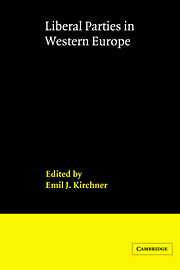Book contents
- Frontmatter
- Contents
- List of tables
- List of diagrams
- List of maps
- Notes on the contributors
- Preface
- 1 Introduction
- 2 Between left and right: the ambivalence of European liberalism
- 3 Two roads of Italian liberalism: the Partito Repubblicano Italiano (PRI) and the Partito Liberale Italiano (PLI)
- 4 The FDP in the Federal Republic of Germany: the requirements of survival and success
- 5 Great Britain — social liberalism reborn?
- 6 Liberalism in France
- 7 Liberal parties in the Netherlands
- 8 The Belgian liberal parties: economic radicals and social conservatives
- 9 The Freiheitliche Partei Österreichs: protest party or governing party?
- 10 The Swedish Liberal Party: The politics of unholy alliances
- 11 Liberalism in Denmark: agrarian, radical and still influential
- 12 The Norwegian Liberal Party: from political pioneer to political footnote
- 13 Liberal parties in Finland: from perennial coalition actors to an extra-parliamentary role
- 14 Liberal parties in Switzerland
- 15 The Luxemburg Liberal Party
- 16 Identifying liberal parties
- 17 Ambivalence revisited: an analysis of liberal party manifestos since 1945
- 18 Transnational links: the ELD and Liberal Party Group in the European Parliament
- 19 Western European liberal parties: developments since 1945 and prospects for the future
- Index of political parties
- General index
1 - Introduction
Published online by Cambridge University Press: 16 November 2009
- Frontmatter
- Contents
- List of tables
- List of diagrams
- List of maps
- Notes on the contributors
- Preface
- 1 Introduction
- 2 Between left and right: the ambivalence of European liberalism
- 3 Two roads of Italian liberalism: the Partito Repubblicano Italiano (PRI) and the Partito Liberale Italiano (PLI)
- 4 The FDP in the Federal Republic of Germany: the requirements of survival and success
- 5 Great Britain — social liberalism reborn?
- 6 Liberalism in France
- 7 Liberal parties in the Netherlands
- 8 The Belgian liberal parties: economic radicals and social conservatives
- 9 The Freiheitliche Partei Österreichs: protest party or governing party?
- 10 The Swedish Liberal Party: The politics of unholy alliances
- 11 Liberalism in Denmark: agrarian, radical and still influential
- 12 The Norwegian Liberal Party: from political pioneer to political footnote
- 13 Liberal parties in Finland: from perennial coalition actors to an extra-parliamentary role
- 14 Liberal parties in Switzerland
- 15 The Luxemburg Liberal Party
- 16 Identifying liberal parties
- 17 Ambivalence revisited: an analysis of liberal party manifestos since 1945
- 18 Transnational links: the ELD and Liberal Party Group in the European Parliament
- 19 Western European liberal parties: developments since 1945 and prospects for the future
- Index of political parties
- General index
Summary
The study of political parties has long attracted the attention of social scientists with widely divergent interests and aims. Whether they have concentrated, for example, upon questions of internal party structure and organisation, the tasks of electoral mobilisation and interest aggregation or the overall effects of system change, it has invariably been assumed that parties have played and will continue to play indispensable roles in the political systems of Western democracies. This remains the case despite recent claims that parties are in ‘decline’ as a result of increasing bureaucratisation of the political process and the development of the ‘corporate’ state, doubts about the existence of genuine policy differences between parties and the increase in electoral volatility amongst the mass public.
Yet, whilst acknowledging the prominent place political parties have generally held in academic studies, liberal parties have been largely neglected as objects of such studies. Though liberal parties of four Western European countries are dealt with in the book by Morgan and Silvestri (1982), their analysis also contains conservative parties and they do not employ a systematic framework for comparing either type of liberal party. Similarly, though describing general features of liberal parties in terms of ideology, history and organisational features, the books by Stammen (1978) and von Beyme (1985) do not attempt a systematic comparison between liberal parties. There are no apparent reasons for the neglect of liberal party analysis although there are frequent references to liberal parties as ‘minor’ parties, presumably purely on the basis of size rather than influence or attraction over time.
- Type
- Chapter
- Information
- Liberal Parties in Western Europe , pp. 1 - 15Publisher: Cambridge University PressPrint publication year: 1988
- 2
- Cited by

